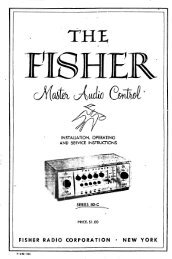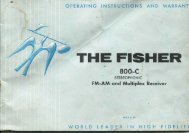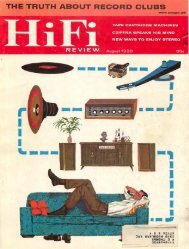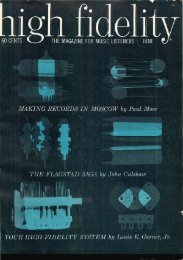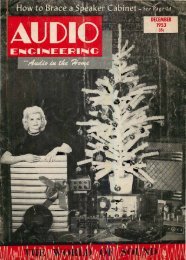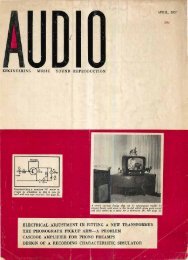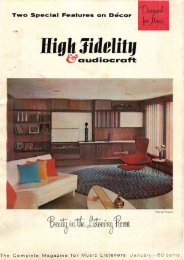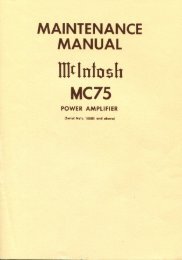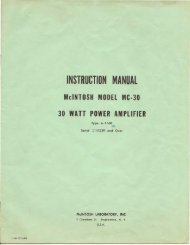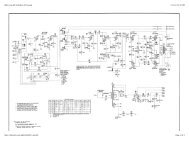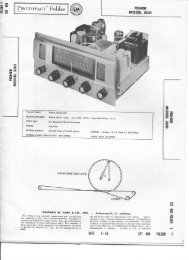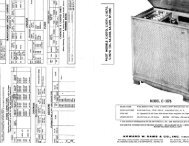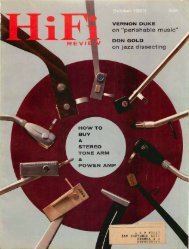~flr'6,r"®
Hifi Stereo Review â July 1958 - Vintage Vacuum Audio
Hifi Stereo Review â July 1958 - Vintage Vacuum Audio
- No tags were found...
Create successful ePaper yourself
Turn your PDF publications into a flip-book with our unique Google optimized e-Paper software.
Two Aspects of a Rhapsody<br />
• GERSHWIN: Rhapsody in Blue; An<br />
American in Paris.<br />
Reid Nibley with the Utah Symphony Orchestra,<br />
Maurice Abravanel condo Westminster<br />
XWN 18687.<br />
• GERSHWIN: Rhapsody in Blue (jazz<br />
orchestration); 7 Songs.<br />
W inifred Atwell (piano) with Ted Heath<br />
and His Music & with guitar, bass and drum<br />
t rio. London LL 1749.<br />
Chief interest in the London recording<br />
lies in the use of an orchestra of jazz proportions<br />
as the instrumental partner in the<br />
performance. To ears accustomed to hearing<br />
the symphonic sound, the stringless,<br />
saxophone-rich timbres of the Ted Heath<br />
aggregation are uniquely indigenous to<br />
the music-up to the point where the big<br />
romantic theme of the piece appears (th~<br />
melody used for so long by Paul Whiteman<br />
as his identifying theme music).<br />
Here, the scoring for saxophone ensemble<br />
sounds for all the world like a poor man's<br />
imitation of the Ray Anthony band imitating<br />
the sound of Glenn Miller.<br />
The competing Westminster recording<br />
offers the standard Ferde Grofe symphonic<br />
orchestration, handled in fine style by<br />
Abravanel and quite surprisingly well<br />
played by the Utah Symphony Orchestra.<br />
The pianist, a respected member of his<br />
local community, but almost totally unknown<br />
outside of it, is revealed as a sensitive,<br />
responsive musician. I find more<br />
of a rhapsodic, jazz flavor in this performance<br />
than in the consciously, affectedly<br />
jazz version on the London disc. The<br />
Westminster is now my preferred recording<br />
(with Morton Gould's a close second)<br />
of this enduring American classic.<br />
On the reverse of the W estminster disc<br />
Abravanel offers a splendid reading of An<br />
American in Paris, one which can compare<br />
favorably with Bernstein's nearly<br />
decade-old performance for RCA Victor.<br />
Atwell, for her part devotes the other<br />
side of her disc to seven of Gershwin's<br />
finest songs, playing them with fluency<br />
and contagious enthusiasm. The accompanying<br />
trio ( guitar, bass and drums ) is<br />
caught up in the· spirit and tlus side<br />
emerges as a winner.<br />
Both discs are well-engineered, with<br />
good sound and a natural balance between<br />
piano and orchestra.<br />
M. B.<br />
that the music is not simple enough.<br />
When Mr. Moore wrote it in 1937-38, he<br />
could not quite manage to avoid Puccinian<br />
lushness and to score with the economy<br />
he has since brought to his increasingly<br />
brilliant operatic ventures. Yet, he<br />
and Benet did come up with a stage piece<br />
that has stood the test of tinle and of<br />
many performances. It is, in its way, masterly.<br />
It tells a good story and provokes<br />
thought. Moore has always known how<br />
to write a tune and how to illustrate an<br />
idea trenchantly.<br />
This performance, by American soloists<br />
and an unidentified "Festival Choir<br />
and Orchestra" under Armando Aliberti,<br />
lacks one thing conspicuously: a dramatic<br />
director. Kurt List, who produced the<br />
DOV Gl-AS M O OR,<br />
e il Ina<br />
aniel ~bster<br />
I<br />
disc, is an excellent musician; but he did<br />
not succeed-if he tried-in making the<br />
singers become actors too. Lawrence<br />
Winters, for instance, who sings Daniel<br />
Webster with rolling sonority, is unconvincing<br />
when he speaks. Joe Blankenship<br />
and Doris Young make mere cardboard<br />
figures of Jabez and Mary Stone, though<br />
they too sing most beautifully. The one<br />
fine characterization is given by Frederick<br />
Weidner as Mr. Scratch (the diabolic<br />
"Boston lawyer") , and he followed closely<br />
by James de Groat as the Fiddler at<br />
the terrifying wedding celebration. There<br />
is also a sense of haste in the performance<br />
which may have had something to do with<br />
the lengtll limitation of a 12-inch disc.<br />
These reservations aside, it is good to<br />
have this delightful piece on records at<br />
last; may it help to bring about many<br />
more live performances of what has become<br />
a real American classic.<br />
K. G. R.<br />
• SC HOE N BERG: Orchestral Variations,<br />
Op. 31; Serenade for low voice and<br />
septet, Op. 24; Four Vocal Pieces, Op. 27;<br />
Canon , Op. 28, No. 1.<br />
Vocal Soloists and Orchestra, Robert Craft<br />
condo Columbia ML 5244.<br />
By more or less common consent, the<br />
four composers represented on these tluee<br />
discs are the most potent influences in the<br />
music of this century thus far. Hardly a<br />
montll passes witllout an addition to their<br />
works-on-record.<br />
Stravinsky's Piano Concerto of 1924 is<br />
a coruscating score. It is an incisive, refreshing,<br />
and highly satiric stylization of<br />
17tll and 18th century musical practice.<br />
When played with tlle motoric brightness<br />
that Seeman brings to bear, it is a<br />
genuine delight. Scherman conducts with<br />
understanding, and the entire effort may<br />
be a match for the other existing version,<br />
MagalofF's with Ansermet (which, however,<br />
contains also the perfect complement<br />
on the overside, the Capriccio of<br />
1929 ).<br />
In the Bartok Sonata (1937), Seeman<br />
is joined by a competent partner and two<br />
good percussionists, for one of many fine<br />
readings that have been made of tills<br />
major score. Fascinating music, tills, by<br />
turns transparent and impenetrable, hilarious<br />
and grim. One could stand I think<br />
to have the percussion miked clo ~er to get<br />
full value from tlle fantastic sonorities.<br />
Although the individual movements vary,<br />
the overall timing of this performance<br />
comes witIun seconds of Bart6k's own:<br />
22'24".<br />
Decca's new Hindemith disc is very<br />
enjoyable, all works in their first (or only<br />
current) recordings. The Concert Music,<br />
Op. 49, I cannot warm up to. It belongs<br />
_......<br />
I. Itl l~ I) F. I~ ITli<br />
-:::::-:::.:::::!:: p,,, ..... " ........ (fl>cft t_ II"",.., .. p . .t~ ...<br />
...,.......,rl"r""'._tw.t,....'J',.1...<br />
"'''jI,J!




